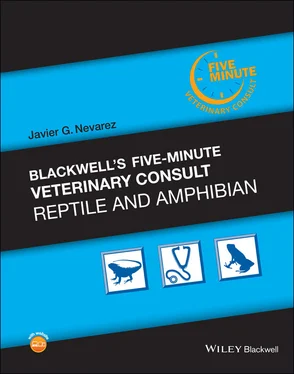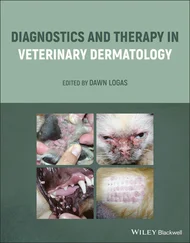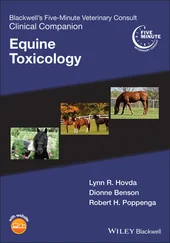Javier G. Nevarez - Blackwell's Five-Minute Veterinary Consult - Reptile and Amphibian
Здесь есть возможность читать онлайн «Javier G. Nevarez - Blackwell's Five-Minute Veterinary Consult - Reptile and Amphibian» — ознакомительный отрывок электронной книги совершенно бесплатно, а после прочтения отрывка купить полную версию. В некоторых случаях можно слушать аудио, скачать через торрент в формате fb2 и присутствует краткое содержание. Жанр: unrecognised, на английском языке. Описание произведения, (предисловие) а так же отзывы посетителей доступны на портале библиотеки ЛибКат.
- Название:Blackwell's Five-Minute Veterinary Consult: Reptile and Amphibian
- Автор:
- Жанр:
- Год:неизвестен
- ISBN:нет данных
- Рейтинг книги:4 / 5. Голосов: 1
-
Избранное:Добавить в избранное
- Отзывы:
-
Ваша оценка:
- 80
- 1
- 2
- 3
- 4
- 5
Blackwell's Five-Minute Veterinary Consult: Reptile and Amphibian: краткое содержание, описание и аннотация
Предлагаем к чтению аннотацию, описание, краткое содержание или предисловие (зависит от того, что написал сам автор книги «Blackwell's Five-Minute Veterinary Consult: Reptile and Amphibian»). Если вы не нашли необходимую информацию о книге — напишите в комментариях, мы постараемся отыскать её.
STAY UP TO DATE ON THE BEST PRACTICES FOR TREATING COMMON DISEASES IN REPTILES AND AMPHIBIANS Blackwell’s Five-Minute Veterinary Consult: Reptile and Amphibian
Blackwell’s Five-Minute Veterinary Consult: Reptile and Amphibian
Blackwell's Five-Minute Veterinary Consult: Reptile and Amphibian — читать онлайн ознакомительный отрывок
Ниже представлен текст книги, разбитый по страницам. Система сохранения места последней прочитанной страницы, позволяет с удобством читать онлайн бесплатно книгу «Blackwell's Five-Minute Veterinary Consult: Reptile and Amphibian», без необходимости каждый раз заново искать на чём Вы остановились. Поставьте закладку, и сможете в любой момент перейти на страницу, на которой закончили чтение.
Интервал:
Закладка:
Finally, one must also be aware of the behavior and personalities of different reptile species. Green iguanas are very gregarious animals living in large groups under constant struggle for territory. Therefore, iguanas maintained alone will show similar behaviors expressed as a willingness to share space and time with the owner but also establishing clear territory demarcations. Adult male iguanas can become very aggressive and territorial during the breeding season. Snakes, on the other hand, tend to be solitary and show aggressiveness as a sign of defense and fear, not as an effort to establish territory. Turtles and tortoises can be solitary or gregarious and, for the most part, are very timid. Being familiar with these aspects about each group of reptiles will help you design a plan for restraint as well as make appropriate husbandry and dietary recommendations.
A thorough knowledge of the anatomy of reptiles is essential for interpretation of physical exam, diagnostic tests, and during surgical procedures. The skin of most reptiles is covered with scales; in some species there are osteoderms, or bony plates under the scales. The mucous membranes of reptiles are usually lighter in color than mammals and can be somewhat tacky, making assessment of hydration status more challenging. In addition, some species have pigmentation of the oral mucosa. For example, bearded dragons have a yellow coloration of the mucosa in their oral cavity. The position of the eyes may help in assessing hydration status, but some species (e.g., chameleons) are able to voluntarily retract their eyes, which negates eye position as an indication of dehydration. Some reptiles have eyelids, while others rely on spectacles (a skin layer covering the eye) to protect the cornea. Reptiles may have pleurodont or acrodont teeth. Pleurodont teeth have no socket, attach on the lateral aspect of the mandible, and are replaced throughout life. Acrodont teeth have firm attachments via sockets and are not replaced. Extra care must therefore be taken when examining the oral cavity of reptiles with acrodont teeth (e.g., chameleons and agamids). The tongues of reptiles range from a moveable structure (e.g., snakes, monitor lizards) to a fixed structure (e.g., crocodilians). Green iguanas have a red to purple coloration on the tip of their tongue, which is normal and must not be confused with trauma or necrosis. The musculoskeletal system is also very different, with some having no limbs (e.g., snakes) while some have additional adaptations such as prehensile tails (e.g., chameleons) and tail autotomy (e.g., green iguanas).
Reproduction of reptiles occurs primarily as vivipary (give birth to live young) or ovipary (lay eggs). Some species are parthenogenic (asexual reproduction, species are females only). It is important to know that intact reptiles may show reproductive behaviors even in the absence of a mate. This is especially important in oviparous species, which can develop and lay infertile eggs, to the surprise of the owner. It is important to ensure proper calcium intake in these species to prevent dystocia problems. Some species will also decrease their activity and will eat less or become anorectic during certain times of the year, all associated with reproductive activity.
Knowledge of internal anatomy is critical for surgery and radiographic interpretation. Reptiles do not have a diaphragm, so the viscera and the lungs are found within the same cavity, the coelomic cavity. Radiographically, the lungs may be observed to occupy over 50% of the coelomic cavity, especially during inspiration. The detail of the viscera is usually less rewarding, and the goal is to identify any well‐demarcated masses that may appear out of place within the cavity. In females, follicles and/or eggs may be observed if they are reproductively active. The bony opacity should appear similar to that observed in mammals. Reduced bone opacity may be an indication of metabolic disease. Mineralization of the kidneys, joints, or other viscera is indicative of salt/mineral deposits, usually composed of calcium and causing pseudo gout. Uric acid is radiolucent, so gout does not manifest itself radiographically. In some cases of gout there is a combination of uric acid and calcium crystals, which are visible on radiographs.
Radiographs are also rewarding for identifying fracture of the long bones. Spinal and pelvic fractures may be more challenging to visualize. Ultrasound, fluoroscopy, contrast studies, computed tomography, and magnetic resonance imaging can all be useful in the reptiles, but interpretation is challenging for those unfamiliar with normal anatomy. Some reptile species have a dark pigmentation of their internal mucosa and connective tissues. This pigmentation is normal but can make visualization of organs and tissues difficult during coelioscopy or surgery. Herbivorous reptiles will have a large cecum, which must be avoided during incision of the coelomic cavity. In lizards, there is a ventral abdominal vessel that runs on the ventral midline superficially underneath the skin. For this reason, it is recommended that, in lizards, a paramedian incision be made cranial to the umbilicus, to avoid lacerating this vessel. The vessel splits into a left and right branch at the umbilicus, so a midline incision can be made caudal to this point.
Metabolic activity is the key feature in maintaining health and homeostasis in reptiles. The body temperature of reptiles is primarily regulated by environmental temperature. Reptiles in captivity therefore rely on their caregivers to provide the appropriate temperature for support of normal body functions. All body systems are regulated and stimulated by temperature. Appropriate environmental temperature will lead to a more active metabolism, stronger immune system, and better ability to resist and cope with diseases. Inadequate, low temperature is one of the most common husbandry mistakes when housing reptiles. These colder temperatures can contribute to impaired immunity, respiratory infections, decreased appetite and gut motility, and can eventually lead to a catabolic state that predisposes to disease and even death.
The medical care of the sick reptile is an important consideration if one decides to see them as patients in practice. The first step is to have all the appropriate equipment to care for these patients. While some equipment may be shared by all species, other is more specialized. Box 1presents a list of equipment and medications that are commonly used for treating reptiles in practice. It is also important to note that the environment provided in a veterinary clinic or hospital is aimed at short‐term housing that will temporarily provide the reptile with appropriate temperature, lighting and nutrition. In the meantime the owner must correct any husbandry issues and prepare the enclosure for when the animal is discharged.
Box 1.Equipment and medications useful for treating reptile patients
Equipment
Gram scale (capacity of 3–4 kg)
Oral speculums (rubber, plastic, and/or wood)
Welding gloves
22‐g, 25‐g, 26‐g needles
1‐cc, 3‐cc syringes
U‐100 30‐unit (0.3‐cc) insulin syringes (BD Consumer Healthcare, NJ, 07417)
BD Microtainer™ tubes for blood collection (0.5 ml capacity) (BD Vacutainer Systems, NJ, 07417)
22‐g, 24‐g, 26‐g intravenous catheters
Glass capillary tubes (with and without heparin) and clay for packed cell volume
1‐inch bandaging material
Sexing probes
Metal feeding tubes with ball tip
Assorted red rubber tubes
Sizes 1–6 cuffed or uncuffed endotracheal tubes
Doppler
Flexible temperature probe and thermometer
Respiratory monitor
Heat lamps
Heating pads and/or forced air warmers (Bair Hugger™, Augustine Medical, Inc., Eden Prairie, MN)
Читать дальшеИнтервал:
Закладка:
Похожие книги на «Blackwell's Five-Minute Veterinary Consult: Reptile and Amphibian»
Представляем Вашему вниманию похожие книги на «Blackwell's Five-Minute Veterinary Consult: Reptile and Amphibian» списком для выбора. Мы отобрали схожую по названию и смыслу литературу в надежде предоставить читателям больше вариантов отыскать новые, интересные, ещё непрочитанные произведения.
Обсуждение, отзывы о книге «Blackwell's Five-Minute Veterinary Consult: Reptile and Amphibian» и просто собственные мнения читателей. Оставьте ваши комментарии, напишите, что Вы думаете о произведении, его смысле или главных героях. Укажите что конкретно понравилось, а что нет, и почему Вы так считаете.












